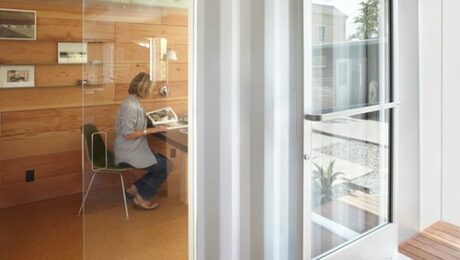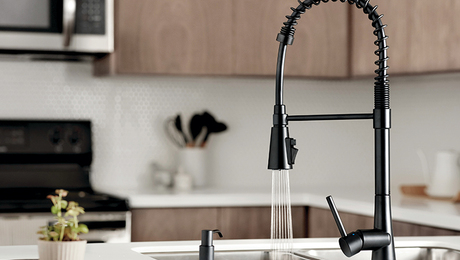Retrofitting a Low-Slope Roof
My 67 y/o mid-century modern, Seattle home (Zone 4) needs a new roof, and I’m proposing adding insulation under a new standing seam metal roof… but I have questions.
The attached PDF diagrams the proposed design.
QUESTIONS
- Insulation value: Given the air flow in the roof cavity, what insulation performance can I expect from the addition of 2 inches of Polyiso to the roof?
(My thought is that the ceiling heats the air in the ceiling cavity, which loses heat through the roof, and so reducing heat loss from the ceiling cavity by insulating the roof will keep the house warmer). - Powered vent: 2 of the 3 roofing companies I’ve engaged to give quotes insist that a passive ridge vent is essential. I’m concerned that in the winter a vent will cool the ceiling cavity and so suck heat from the ceiling. One contractor offered the option of a powered ridge vent fan, which could be turned on and off, e.g., based on moisture content. In the winter it could be used sparingly and allow warm air to remain in the ceiling cavity. But I’m unable to find such fan. Do you know of one?
- Venting necessary: The roof has been unvented since the house was built in 1955, with no apparent ill effect. Do you see any reason why adding insulation to the roof will necessitate additional venting?
- Other: Are you aware of other solutions or ideas?
Thanks
GBA Detail Library
A collection of one thousand construction details organized by climate and house part









Replies
It doesn't look like your existing roof is unvented as it has soffit vents. Since it is missing a ridge it is not ideal but it doesn't mean that it doesn't work.
As for the new roof, how big are your existing rafters?
2" of polyiso (say R11.5) is good for condensation control for about R28 of fluffy insulation in zone 4. As long as you have about that or less between your rafters, you don't need any venting. The soffit vents should be closed up and air sealed as much as possible. Any vent space above the existing batts should be filled with batts or dense packed. Adding a ridge vent short circuits the rigid insulation on the roof, might as well not install any at that point.
I don't know why you would have DensDeck under a metal roof. Metal roofs are typically attached to either OSB/CDX or strapping.
MaxRoof,
Akos has given you good advice.
Just to answer your question #3: Adding insulation changes everything. It makes the structure colder, so it is more prone to moisture damage by staying wetter. It also moves the dew point, which means condensation is liable to occur at a different place in the roof. Adding insulation without the requisite air-sealing and ventilation causes a lot of buildings that have been fine for decades to have problems.
Malcolm is right in that adding insulation changes everything. But that doesn't necessarily mean that adding insulation to your specific roof will require additional ventilation. In fact, the opposite is true. Adding insulation to the top of the roof deck will have little to no value if the ceiling cavities are vented, as the vents are bringing unconditioned exterior into the cavities under the roof deck and warming/chilling the ceiling surface directly.
1. your thought about the ceiling heating the cavity is somewhat correct in winter, but not at all in summer. In summer, the outside air is warmer than inside, even in Seattle. So bringing outside air into the ceiling cavity will warm the ceilings, not the other way around. There are two primary heat flows into your interior ceiling in summer: Conduction/ convection of warm exterior air and radiation/convection of heat from the sun. Painting the roof white decreased the second effect by limiting the roof's temperature gain from solar radiation and with lower temperature roofing, you get less re-radiation and convection of that heat to the ceilings below.
As Akos points out, you are safe filling the rafter cavities with fluffy insulation up to about R28 if you are adding 2" of polyiso insulation to the top of the roof deck. You want the cavities completely filled and the soffit vents closed off so that you don't have outside air flowing into any accidental airspace above the fluffy insulation and below the roof deck. Fiberglass batt or blown-in will be pretty close to R28 in a 2x10 rafter cavity. Certainly close enough that you don't have to worry about condensation, even in your coldest weather.
Combining responses from Akos, Malcolm and Peter.
CONCLUSIONS
a) It’s possible, and advisable, without causing ill effects, to fill the ceiling cavity between the rafters with fluffy insulation, without the need for either soffit or ridge venting. If I do that, I need to seal off the existing soffit vents, to prevent moisture laden air from entering and condensing in the space.
b) If I insulate the ceiling space, there’s no need to put Polyiso on the roof, per my proposal in the attached PDF.
QUESTIONS
1. “Fluffy insulation”, in this context, refers to blown in fiberglass, correct? If there are other options, which would you recommend for Zone 4?
2. There are areas of my ceiling cavity where vents or skylights might prevent access from the peripheral fascia boards. Is it practical to blow this in from above during the process of replacing the roof. For example by lifting/drilling the roof sheathing to access the hard-to-reach places? (By “practical” I mean that the return justifies the cost, including the cost of trying to coordinate the roofers with the insulators).
3. Parts of my ceiling have can lights, which despite our best efforts, are not air tight. This will allow warm air and moisture to get into the ceiling cavity. Will this be a problem over time if there is no ventilation?
4. Malcolm – you say adding insulation makes the structure colder. Do you mean adding insulation above the roof sheath (my proposal) or in the roof cavity (Akos)?
COMMENTS
Akos – Why DenseDeck (same as DenseShield?) under the metal roof? I’m just repeating what I was told by one of the roofers. Apparently the Polyiso needs better load spreading than is provided by the metal panels. Could be some other material.
Thanks gentlemen.
Densedeck is for single ply roofs not a metal roof, denseshield is for walls. For a metal roof above rigid insulation you either strap out the foam with horizontal 1x4 or install another CDX/OSB deck. The metal panels than attach to this wood.
Some metal panel manufactures do offer bearing plates, essentially large steel washers, to spread the load which the panel clips can be screwed. This would avoid the need for any extra wood/strapping above the foam.
I didn't explain well. The "load" in "load spreading" is referring to me walking on the metal.
MaxRoof,
a) Yes
b) No you definitely need to keep the polyiso. The assembly will not work without it (see #3 below).
1. Fluffy insulation can be blown in fiberglass, cellulose or batts.
2. Yes, although it may be easier to just use batts there.
3. The roof top foam is there to keep the sheathing warm enough to stop any moist air from condensing and causing damage. While not ideal, some minor air-leakage at the lights should not be a problem.
4. The reason old un-insulated houses often show very little moisture damage is that their structure is kept warm enough to promote drying. So insulation outside the structure (in your case the foam) is beneficial, while insulation in the cavity can be problematic.
A couple more questions.
1) Should the new fluffy insulation extend outward from the wall to include the eaves? (see attached schematic)
2) With respect to the proposal to seal the soffits; I understand that the heat reflective metal roof and Polyiso will respectively reduce radiant and conductive heating of the ceiling cavity. But during the course of a summer day the ceiling cavity WILL heat up, and the newly installed fluffy insulation will trap that heat, making for some unpleasant summer evenings. Are there any remedies for this, or is this the cost that must be borne for more insulation?